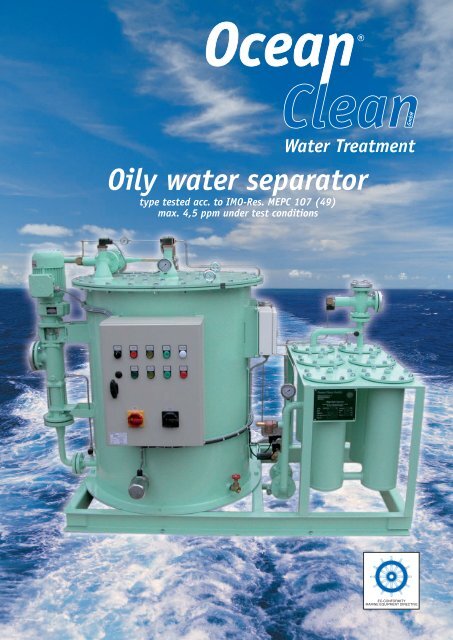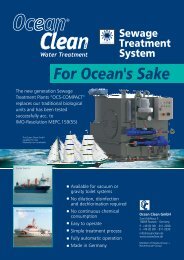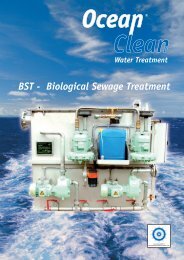Oily water separator - Ocean Clean GmbH
Oily water separator - Ocean Clean GmbH
Oily water separator - Ocean Clean GmbH
Create successful ePaper yourself
Turn your PDF publications into a flip-book with our unique Google optimized e-Paper software.
<strong>Oily</strong> <strong>water</strong> <strong>separator</strong><br />
type tested acc. to IMO-Res. MEPC 107 (49)<br />
max. 4,5 ppm under test conditions<br />
®<br />
<strong>Clean</strong><br />
<strong>GmbH</strong><br />
Water Treatment<br />
EC-CONFORMITY<br />
MARINE EQUIPMENT DIRECTIVE
A<br />
From<br />
Bilge<br />
E<br />
Oil drain<br />
Type A B C D E F a b c d e<br />
EB 0,25 1350 1200 600 800 700 900 DN 25 DN 20 R 3/4” R 3/4” R 3/4” 500 620 0,25<br />
EB 0,50 1350 1200 600 800 750 900 DN 25 DN 20 R 3/4” R 3/4” R 3/4” 550 670 0,50<br />
EB 1,0 1350 1500 600 800 750 900 DN 25 DN 20 R 3/4” R 3/4” R 3/4” 600 720 1,0<br />
EB 2,5 1350 1900 920 1100 750 1000 DN 40 DN 25 DN 25 DN 25 R 3/4” 800 1300 2,5<br />
EB 5,0 1600 1950 1250 1250 800 1000 DN 50 DN 32 DN 35 DN 32 R 3/4” 1000 2000 5,0<br />
®<br />
<strong>Clean</strong><br />
Water Treatment<br />
a<br />
b<br />
control voltage<br />
stage 1 oil<br />
to sludgetank<br />
system off system on<br />
stage 2 oil system fault<br />
to sludgetank<br />
oil <strong>water</strong> pump on<br />
to bilge<br />
main heater<br />
B<br />
made by <strong>Ocean</strong> <strong>Clean</strong> <strong>GmbH</strong><br />
2 1<br />
e<br />
<strong>Ocean</strong> <strong>Clean</strong><br />
EC-CONFORMITY<br />
MARINE EQUIPMENT DIRECTIVE Water<br />
Overboard discharge<br />
<strong>Clean</strong><br />
Treatment<br />
Return to<br />
bilge<br />
Wehrmannsdamm 11 · D-27245 Kirchdorf · GERMANY<br />
Tel. + 49 (0) 42 73 / 96 28 70 · Fax + 49 (0) 42 73 / 96 28 71<br />
www.oceanclean.de · info@oceanclean.de<br />
c<br />
d<br />
F<br />
C<br />
D<br />
®<br />
<strong>GmbH</strong><br />
Weight Capacity<br />
dry wet m 3 /h
Short Description<br />
Make <strong>Ocean</strong>s clean with ”<strong>Ocean</strong> <strong>Clean</strong> ® ”<br />
Bilge Water <strong>separator</strong> approved to IMO-Res. MEPC 107 (49 ).<br />
The “<strong>Ocean</strong> <strong>Clean</strong> EB” series from 0,25 to 5,0 m ³ /h capacity is designed on the background<br />
of 30 years of experience of oil-<strong>water</strong> separation of its designer Dieter van Züren.<br />
The “<strong>Ocean</strong> <strong>Clean</strong>” system fulfilles the test specification of a.m. IMO-Resolution more<br />
than required. The maximum oil content in the effluent <strong>water</strong> is less than 5 ppm. The<br />
“<strong>Ocean</strong> <strong>Clean</strong> EB” is a 3-stage oil-<strong>water</strong>-emulsion separating system.<br />
The first stage is a gravity coarse separation stage, able to separate the input of up to<br />
100% oil, without stops for flushing intervals. The oil <strong>water</strong> separation is forced by a<br />
special inlet, producing a hydrocyclone effect.<br />
The second stage is a coalescence stage, separating finest oil droplets from the <strong>water</strong>.<br />
The coalescer is made of oil-and acid resistant Polyether-foam, self cleaned by<br />
automatic backflushing. Its life time is 3-5 years.<br />
The separated oil is detected by conductive measuring method and drained by<br />
automatic operated drain valves.<br />
st nd<br />
There are no moving parts inside the 1 and 2 . stage<br />
The third stage is an emulsion breaking stage by means of special infused filter<br />
membranes with hydrophobic surface, a.e. <strong>water</strong> can flow through it, but every oil<br />
particles of an emulsion are retained.<br />
The de-oiled and emulsion-free <strong>water</strong> is, after passing a 15 ppm alarm (to be adjusted<br />
to 5 ppm) discharged to overboard. The life time of the filter membranes is approx. 2<br />
years.<br />
Because of the systems pump is pressing the bilge <strong>water</strong> through it, there are no<br />
restrictions regarding the suction head. For a suction head of above 6 mtr., the pump<br />
may be installed apart from the <strong>separator</strong> on a lower position.<br />
The “<strong>Ocean</strong> <strong>Clean</strong> EB” bilge <strong>water</strong> <strong>separator</strong> in standard is delivered ready to plug on,<br />
with all internal piping and wiring.
System description<br />
The “<strong>Ocean</strong> <strong>Clean</strong>“ oily <strong>water</strong> <strong>separator</strong> system is a 3-stage, combined gravity, cross<br />
fluked membrane-filter system, manual or automatic operated. Maintenance and<br />
changing parts are reduced to a minimum.<br />
The oily <strong>water</strong> from bilge or bilge <strong>water</strong> collecting tank is led via the transfer pump<br />
into the 1 st stage, the coarse separation stage. The inlet pipe is prepared like a hydro<br />
cyclone which brings the inlet mixture into rotation. The lighter medium oil is moving<br />
to the centre of the tank, where it is easily detected by the conductive sensing<br />
electrode. The sensing electrode<br />
N 1.1 is measuring the electric resistance of oil and <strong>water</strong> between its sensors A and B.<br />
Water is a good electric leader whilst the electric resistance of oil is ∞. That means, if<br />
the sensors A and B (C is only mass) are surrounded by oil, no electric flow can be<br />
between them. This signal is taken by the sensing relais N1, operating the necessary<br />
steps in the switch box to operate the necessary valves and pump operations.<br />
The outlet of the oil drain valves V1 and V2 is specially designed as a self-sensorcleaning-device.<br />
If the oil drain valves are open, the oil and at the end some <strong>water</strong><br />
passes the sensor with high velocity, cleaning the sensor automatically from clogged oil<br />
residues.<br />
During valve V1 is open for oil drain, valve V3 is closed.<br />
If there is no oil at the sensor N1.1 of the 1 st stage, valve V1 is closed. The mixture is<br />
entering from below and streams through the coalescence insert from below to the<br />
top, forming big oil bubbles from a summary of small droplets.<br />
Separated oil is detected by sensor N2.1 and drained by valve V2.<br />
Whilst oil draining phase of 2 nd stage, valve V 3 is closed. The pump stops<br />
automatically. Valve V 4 opens for back flushing with sea- or fresh<strong>water</strong> from hydroforsystem.<br />
The pressure of the back flushing <strong>water</strong> is regulated by the pressure regulating<br />
valve V 5 to be adjusted to 2 bar. After the oil is drained and the sensor is surrounded<br />
by <strong>water</strong> again, the unit switches over to normal operation condition.<br />
After passing the 1 st and 2 nd stage, the remaining deoiled <strong>water</strong> passes the EM-columns<br />
and after this the polishing columns, which are switched in series. The clean <strong>water</strong> –<br />
free of oil and emulsions – passes valve V 6 – to the overboard discharge.<br />
Between the last polishing column and valve V 6 there is a by-pass pipe to the 15 ppmalarm<br />
and back to bilge/bilge tank. The 15 ppm-alarm is continuously detecting the oil<br />
content. As soon as this is increasing to more than 15 ppm the valve V 6 switches over,<br />
overboard discharge is stopped and the <strong>water</strong> flows back to bilge/bilge tank.
page 9.1<br />
1st. stage<br />
coalescense<br />
2nd stage<br />
coalescer<br />
from bilge<br />
oil drain<br />
A<br />
B<br />
C<br />
V8<br />
drain<br />
N1.1<br />
V1 N2.1<br />
V2<br />
flushing<br />
V3<br />
EB - <strong>Oily</strong> Water Separator<br />
Operation Diagramm<br />
emulsion<br />
breaker<br />
overboard discharge<br />
drain<br />
polishing<br />
stage





